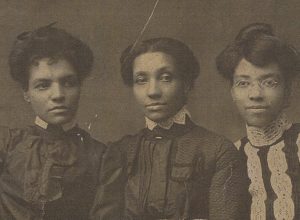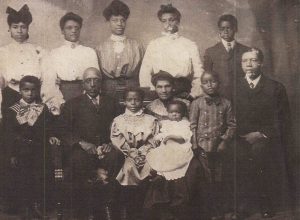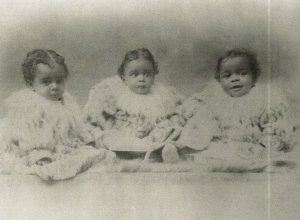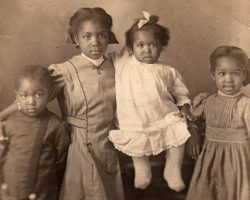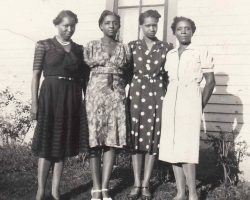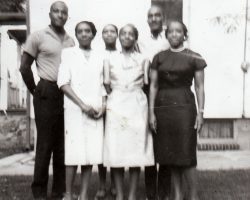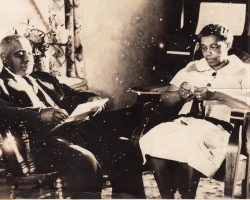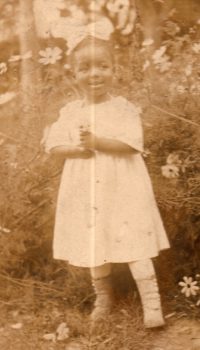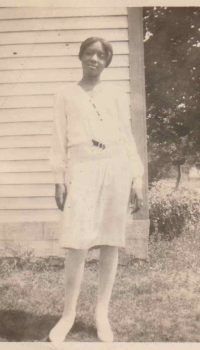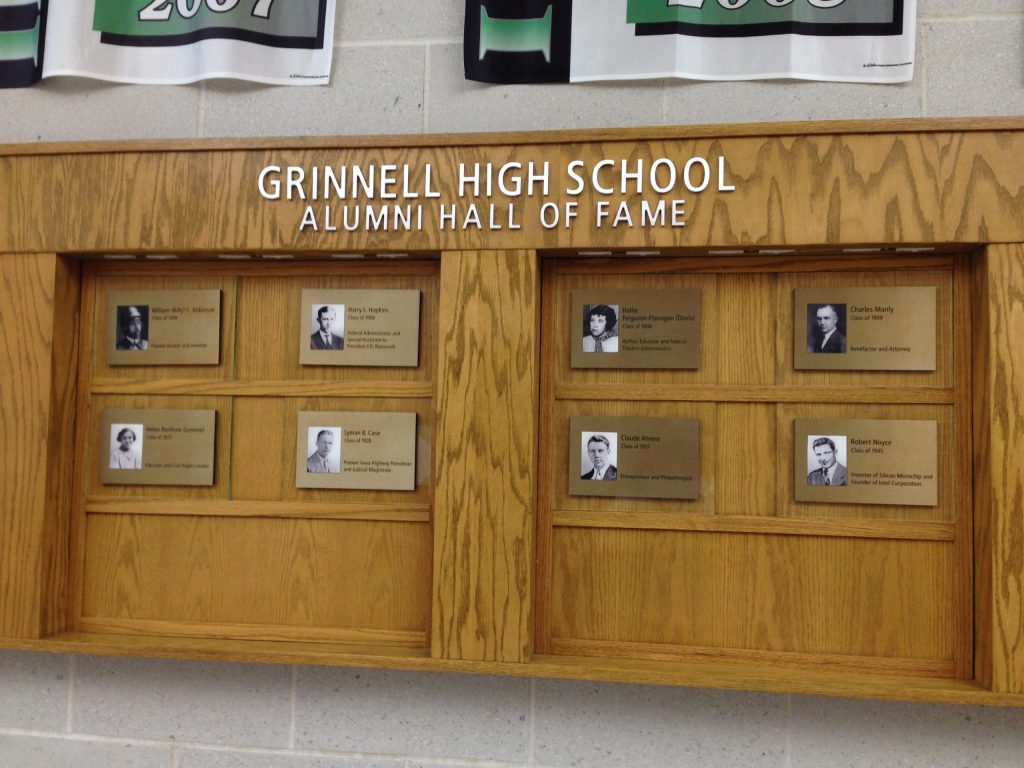The Renfrow Story: Bridging Campus & Community
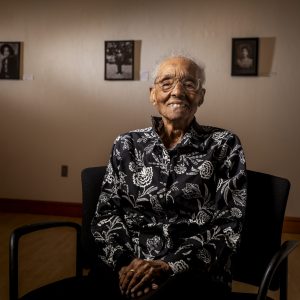
Edith Renfrow Smith, Age 107. Photo by Justin Hayworth, Grinnell College (c2021)
Edith Renfrow Smith was born in Grinnell in 1914. She was raised in the community, attended Davis School through 6th grade and graduated from Grinnell High School in 1932. She became the first Black woman to graduate from Grinnell College in 1937.
In 2022, at age 108, she is the oldest living alumna of both Grinnell High School and Grinnell College. Throughout her life, she has lived by her mother’s motto: “Nobody is better than you.” Her life is a testament to the power of positivity and kindness and is an example all Grinnellians can embrace.
In December 2022, two major announcements were made:
- She become the newest inductee into the Grinnell High School Alumni Hall of Fame
- Grinnell College will name their newest building Renfrow Hall in her honor
Given her significance as both a native Grinnell resident and college graduate, this series tells the story of her and her family
Deep Roots: The Craig, Lucas, and Renfrow Families
When Lee Augustus and Eva Pearl Craig Renfrow (parents of Edith Renfrow Smith) married in Grinnell in 1901, the roots of their families were already well established in Poweshiek County. They brought with them remarkable stories of escape from enslavement. Eva Pearl’s parents, George and Eliza Jane Craig, had arrived in the community in the 1890s, having been in the Oskaloosa area since their marriage in 1862.
George Craig (grandfather of Edith) was born into slavery in Missouri. In order to save himself from being sold down South, he rubbed tobacco juice in his eyes to decrease his value on the auction block. At the age of 19, he escaped and was protected by abolitionists in Leavenworth, Kansas. Hidden there for nearly a year because of the large bounty for his capture, he finally made his way to Grinnell via the Underground Railroad network, traveling with John Brown in 1859. This story was told to the Leavenworth Times by Mr. Craig himself, and reprinted in the Grinnell Herald in March 1895.
Eliza Jane Craig (grandmother to Edith) was also born into slavery. Her mother was a slave named Jane. Her father was a French plantation owner, Antoine Gilbal, in South Carolina. Eliza was the third child from this relationship. Before his death, Gilbal sent the children north to freedom, making arrangements for them to be financially supported. Jane was to be freed at his death to follow the children, but his wishes were not honored and she remained enslaved, never to see her children again. This story was recounted in an article in The Crisis, an NAACP publication, in 1937, on the occasion of Edith Renfrow’s graduation from Grinnell College.
George and Eliza Craig had three daughters – Anna, Theodora and Eva Pearl. The lived mostly in Oskaloosa, Iowa, from around 1870 until 1890, when the entire family relocated to Grinnell. Each of the daughters would marry and live in Grinnell for a significant part of their lives. Theodora married John Brown Lucas in 1885; Anna married Ed Goode in 1887; and Eva Pearl married Lee Augustus Renfrow in 1901. Goerge and Eliza would lived the rest oftheir lives in Grinnell, surrounded by their children and grandchildren.
When Theodora (Aunt to Edith) married John B. Lucas, she connected the family to the first Black man to own land in Poweshiek County. John’s father, Henry Lucas, had purchased land near Ewart in 1859. He led an extraordinary life. Born a slave, he was taken to the front of the Mexican American War. With permission of his owner, he was allowed to earn money while doing work for other officers. By the end of the war he had earned enough to purchase his own freedom. He then spent three years as a gold prospector in California, where he partnered with a man named Robert Morrison, a resident of Poweshiek County. The two unlikely partners found great success and then parted ways, Morrison to Montezuma, Iowa and Henry Lucas to Arkansas, where he purchased the freedom of his wife and children and planned to start a life as a free family. When Act 151 was passed in Arkansas in 1859, making it illegal for freed slaves to live in the state, Henry reconnected with Morrison who encouraged him to bring his family to Iowa.
Henry Lucas’ life story was written by his son, John Brown Lucas (Edith’s Uncle), and was printed in the Grinnell Herald in May 1932. According to that account, he and his wife each held $1000 sewn into the lining of their travel clothes as they made their way to Poweshiek County. Within weeks of their arrival, they purchased the first of many acres of land. By the time the “History of Poweshiek County” was published in 1880, which includes a short biography of this early settler, Henry Lucas owned 320 acres in Pleasant Township, just south of Grinnell. As of 2022, 160 acres of his original farm is still owned by his great-great-grandson.
Theodora and John Lucas (Edith’s Aunt and Uncle) moved to 1517 West Street in Grinnell in 1890. They had 8 children in total, including triplet daughters born in 1895. This was the first recorded birth of triplets in the state of Iowa. In 1887, Theodora’s sister Anna Craig had married a Grinnell man, Ed Goode, and settled in at 715 Spring Street with their son, William. With daughters and grandchildren in Grinnell, it made sense for George and Eliza Craig to move from Oskaloosa. They lived at 515 2nd Avenue. Their youngest daughter, Eva Pearl (Edith’s mother), who was still single at the time, moved to Grinnell with her parents and was especially helpful in the care of the triplets during their early years. She would soon meet Lee Augustus Renfrow to whom she was married in Grinnell in 1901. The Renfrows would spend most of their lives in Grinnell, raising six children in the community.
The Renfrow Family of Grinnell
After their marriage in 1901, Lee and Eva Pearl Renfrow (parents to Edith Renfrow Smith) lived for a short time in Grinnell, where their first child, Helen, was born in 1904. By 1905 they had moved to Red Wing, MN, where they lived for a few years and where their next three children were born: Alice in 1906; Rudolph in 1907; and Evanel in 1908. By 1910 they had found their way back to Grinnell. According to their daughter, Edith, their return was encouraged by Mumford Holland, an elderly Black neighbor who asked Eva Pearl to help care for him during his final years of life. As payment, his home would become hers after his death. So it was that they moved to 511 Second Avenue, the home they inherited from Mumford, which was also next door to Eva Pearl’s parents, George and Eliza Craig.
Lee Augustus Renfrow was primarily a cook, though he offered a variety of services according to available accounts. He was employed at different establishments over the years, most notably at the Monroe Hotel, the preeminent lodging facility in Grinnell during that period. Eva Pearl was active in the community and in a variety of women’s organizations at the time. They were members of the Congregational Church and she kept active raising her children and doing a variety of small jobs to help provide income. The family would often attend concerts and events on the Grinnell College campus, taking advantage of all that was available. Education was a high priority in the Renfrow household. According to their youngest daughter, Edith, missing school was never an option for the children. After a few years on Second Avenue, they moved to 411 First Avenue. The Renfrow children walked to and from home to Davis School, and later to the Junior or Senior High at the corner of Fifth and Park, across from Central Park.
All of the Renfrow children knew it was expected that they would go to college. It was also a family understanding that they would work together to help support one another to achieve that goal. All of them worked in service jobs, there being few other positions open to Black people in Grinnell at the time. Their commitment to education and to one another enabled each of them to attend and complete college, then have successful careers.
The eldest, Helen (1904-1968), attended Fisk University and then the University of Iowa, where she later worked as a research technician in the internal medicine lab. She married Allyn Lemme and they became civil rights leaders in Iowa City. They helped support Black students at the University of Iowa during the time when Blacks were not allowed to live on campus. The Helen Lemme Elementary School in Iowa City is named in her honor, commemorating the impact she had on the community. Helen Renfrow Lemme is in the Grinnell High School Alumni Hall of Fame.
Alice Renfrow (1906-1997) attended Hampton University. In 1935 she accepted a position at the Library of Congress, where she worked for the next 40 years. She is buried with her parents and brothers in Hazelwood Cemetery.
Rudolph, Rudy to his family, Renfrow (1907-1972) attended Hampton and graduated valedictorian of his class. He settled in the D.C. area where he was employed in sales and engaged in civil rights work, including as part of the New Negro Alliance in the 1930s. He is also buried in Hazelwood Cemetery with his parents and sister.
Evanel Renfrow Terrell (1909-1994) received both a Bachelors and Masters degree from the University of Iowa. She went on to a career as a Professor of Home Economics in African American universities across the south, culminating in a 27-year tenure at Savannah State University. She was married to Carl Terrell.
Paul Renfrow (1917-1974) attended school in Chicago. When WW II broke out, he enlisted in the US Army. He was a part of the D-Day invasion and reached the rank of Master Sergeant before his discharge. He became an optician and practiced in Washington, D.C. for most of his life. He is also buried at Hazelwood Cemetery.
Edith Renfrow Smith (1914- ) was the first Black woman to graduate from Grinnell College. At the age of 108, she is the oldest living alumni of both Grinnell High School (1932) and Grinnell College (1937). In 2022, Grinnell College announced their new residential building will be named Renfrow Hall in her honor and she was inducted into the GHS Alumni Hall of Fame. (Learn more about her in the next section)
Edith Renfrow Smith
Edith Renfrow Smith was born on July 14, 1914 in Grinnell, Iowa. She was the fifth of six children born to Lee and Eva Pearl Renfrow, one of the few African American families in Grinnell at the time. The stories of her grandparents’ survival and escapes from the bonds of enslavement were familiar to the Renfrow children, especially to Edith given her close relationship with her mother.
It is the wisdom of her mother that she most often repeats. This has been the guiding principal of her life and the lesson she most wants to share with others:
I don’t care who it is. There is no one born any better than you are. They may have more money, and they may be more beautiful. They may have outward things. But there’s no one any better.
Her childhood in Grinnell spanned the start of World War I to the depths of the Great Depression. Despite many challenges, the Renfrow children all knew that their education was a priority. Life had not allowed their mother to go to school beyond the 8th grade, but she was determined that all of her children would attend college. It was instilled in them that they would work together to attain that goal, each helping the other so that there was enough money for all to go to college. Mrs. Renfrow did all she could to ensure her family was exposed to the benefits that Grinnell had to offer. They often attended concerts and events at Grinnell College as well as in the community.
When Edith was around 5 years old, her mother invited the few Black students attending Grinnell College to their home on Sunday evenings. The students were Rosenwald Scholars, a partnership between Grinnell College and the Rosenwald Foundation to recruit Black men to the college. Edith fondly recalls these visits and how impressed she was by these young men. She had similar impactful experiences with Grinnell College students when she attended the Uncle Sam’s Club. This was a youth club for Grinnell children with a wide variety of after school and weekend activities, mostly run by members of the college branches of the YWCA and YMCA. These students volunteered to spend their time with the children of Grinnell. She was also strongly influenced by Grinnell College professor Laetitia Conard, who was instrumental to the Uncle Sam’s Club and was Edith’s Campfire Girls leader.
From a young age, little Edith was determined to attend Grinnell College. Years later, when asked why, it is these interactions with students that she credits. The students opened her eyes to the world beyond Grinnell. They were interesting and engaging and they encouraged her to believe that she could become one of them.
Edith, like her siblings, would walk to school every day from their home on First Avenue. She attended Davis school, the newest school in town at the time, from Kindergarten through Sixth Grade. After that, she walked to school across from Central Park, attending the Junior and Senior High Schools, including the building that is now home to the Hotel Grinnell. During high school she was active in many activities and sports. Her senior yearbook lists involvement in basketball, volleyball, YWCA, among other things.
She graduated from Grinnell High School in 1932. Determined to attend Grinnell College, she knew that she needed to find a good job to help pay for school. Even if she lived at home, she had to pay tuition. For a year after high school she took classes to improve her secretarial skills, which allowed her to secure two office jobs on campus during the four years she was a student. She enrolled in Grinnell College in 1933. Although she lived off campus, she was considered a part of the Read Hall Women’s group and fondly recalls playing sports and participating in dances and other activities. She was the only Black student on the campus during her entire undergraduate career. When she graduated in 1937, she became the first Black woman in history to graduate from Grinnell College. (Learn more about her time as a student here.)
After college, she moved to Chicago and started a job at the YWCA branch for Black girls and women. Within a few years, she met and married Henry T. Smith and started a family. By 1954, she earned a teaching degree and began a 22 year career as a middle school teacher, becoming a master teacher along the way. When she retired from teaching in 1976, she followed her passion for giving back to the community. For over 40 years she was a regular volunteer at Goodwill and the Art Institute of Chicago, among other organizations. In 2009, she was recognized for her spirit of generosity and was inducted into the Chicago Senior Citizen Hall of Fame. (Learn more about her life after Grinnell here.)
Throughout her life, Mrs. Renfrow Smith has continued to return to Grinnell regularly. She and her husband maintained ownership of the family home on First Avenue until 2004 and are remembered as wonderful landlords by April Van Ersvelde, who was raised in the house. They would regularly come to visit their close friends, Alma and Booker Kiner, who worked the Lucas farm near Ewart. Kay Jack and Heather Eilander of Montezuma, who lived across the road from the Kiners, have shared memories of the visits from Edith and her husband. Mrs. Renfrow Smith also regularly attended her Grinnell College class reunions.
At the age of 108, she will often state that she still considers Grinnell home. Another testament to this deep bond with the community is the fact that her own Smith family plot is at Hazelwood Cemetery. Her husband and older daughter are buried near where her parents and three of her siblings lie. Grinnell will be her final resting.
In October 2022, the Grinnell High School Alumni Association proudly voted to add Mrs. Renfrow Smith to the GHS Alumni Hall of Fame, honoring the inspiration she offers to all Grinnellians. The official installation will take place on December 2nd at an all school Tiger Pride Assembly. Mrs. Renfrow Smith will attend virtually and be able to share her wisdom with the current members of the GHS student body.
She will be the second member of the Renfrow family to be given this honor, joining her sister Helen who was included with the first inductees in 2005. Prior to 2022, individuals had to be deceased in order to be considered for this honor. In considering Edith Renfrow Smith’s nomination, the committee changed to guidelines so that those over 100 years of age could also be considered for inclusion.
The Renfrow ties to Grinnell are deep and strong. Edith Renfrow Smith stands proudly as a True Grinnellian, born and raised in this community, nurtured and inspired by her time at Grinnell College, and at the age of 108 still proudly claiming this place as her beloved home. She does not deny the presence of economic hardship or racial discrimination. But she does not let those things change her love for the community or the College. This, along with her life of service and accomplishment, make her the embodiment of the vision of the Grinnell College Civic Engagement Quad (CEQ), nestled along Broad Street, bridging the space between the campus and downtown.
On December 5th, 2022, Grinnell College announced that the Board of Trustees have unanimously voted to name the residential hall in the CEQ complex Renfrow Hall in honor of Edith Renfrow Smith. Watch the announcement video here and read the Des Moines Register article about the announcement here.
Designed by world renowned architect, Sir David Adjaye, the building will take a prominent place along Broad Street, a path frequented by Mrs. Renfrow Smith in her years as a Grinnell studen.
Resources where you can learn more
Article: John B. Lucas writes a History of the Lucas Family, Grinnell Herald, May 20, 1932
Article: Henry Lucas of Pleasant Township, The History of Poweshiek County, 1880
Article: Slavery Story: Some of George Craig’s Experience as told by him to a Leavenworth Times reporter, Grinnell Herald, March 29, 1895
Article: Old Slave Days: Memories of Grinnell’s only living relic of system long since passed, Grinnell Herald, August 18, 1922
Article: Up from Slavery: The descendant of a slave mother and a French master gets her degree at a middle western college, The Crisis, August 1937
Video: Edith Renfrow Smith interview, program at Drake Community Library, October 7, 2015
Podcast: All Things Grinnell interview with Edith Renfrow Smith in 2019, on the occasion of her receiving an Honorary Doctor of Humane Letters from Grinnell College.
Webpage: Edith Renfrow’s Girlhood in Grinnell
Wikipedia: Edith Renfrow Smith This entry also includes links to other interviews she has done, including an appearance on the Today Show and with the Chicago Sun Times.
Wikipedia: Helen (Renfrow) Lemme Learn about her work for civil rights and the school named in her memory.
Photos: Photos (48 in total) from the Renfrow family collection can be seen in Digital Grinnell by searching for “Renfrow”.
Book: Grinnell Stories: African Americans of Early Grinnell by Dan Kaiser, published by the Grinnell Historical Museum, 2020. Available at Drake Community Library or from purchase from the Pioneer Bookstore.
Book: No One is Better than You: Edith Renfrow Smith and the Power of a Mother’s Words by Monique Shore, published in 2024. This is an illustrated biography of her life that includes extended biographical information and photographs. Learn more at renfrowstory.com. Available at Drake Community Library or from purchase from the Pioneer Bookstore.
Recent Media
Grinnell College names new off-campus dorm after pioneering 108-year-old alum, by Nina Baker. Des Moines Register, December 5, 2022
She was an education pioneer. At 108, Edith Renfrow Smith shares her life lessons, by Claretta Bellamy. NBC News, February 3, 2023.
Meet the woman who has witnessed over 80 years of Black history in Chicago, Scott Simon, NPR Weekend Edition Saturday, February 11, 2023.
New Residence Hall Naming Honors Edith Renfrow Smith, Grinnell Magazine, Spring 2023
Enjoying life immensely at 109, by Neil Steinbert, Chicago Sun-Times, July 13, 2023
At 109, education pioneer Edith Renfrow reflects on ‘The greatest century we have seen’, by Mike Lowe, WGN9 Chicago (includes video), July 13, 2023
Renfrow Videos
In October 2015, at the age of 101, Edith Renfrow Smith did a live oral history interview with Dan Kaiser at Drake Community Library.
In 2019, at the age of 105, Edith Renfrow Smith was presented with an honorary degree from Grinnell College.
Monique Shore presentation on the Renfrow family history in Poweshiek County, starting from 1859. This program was presented on April 12, 2023 as a part of the Community Education Council’s Bucket Course at Drake Community Library.
Tamara Beauboeuf presentation on Edith Renfrow Smith and her years in Grinnell. This program was presented on April 19, 2023 as a part of the Community Education Council’s Bucket Course at Drake Community Library.

